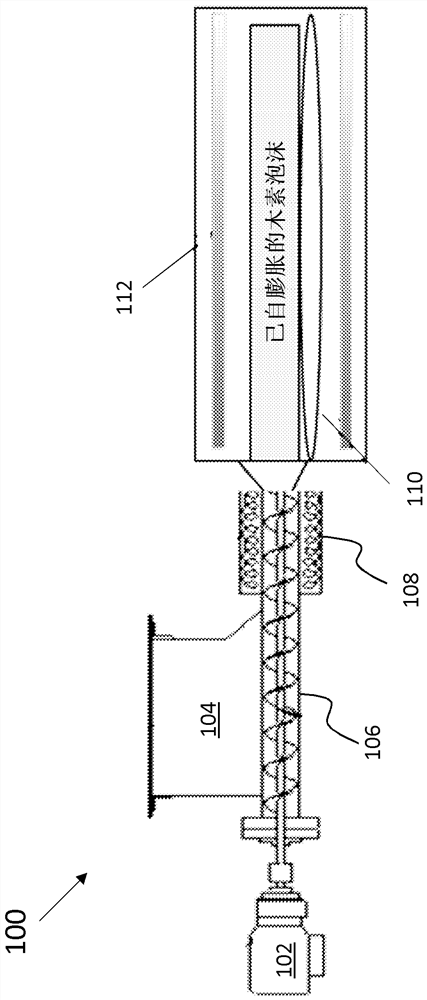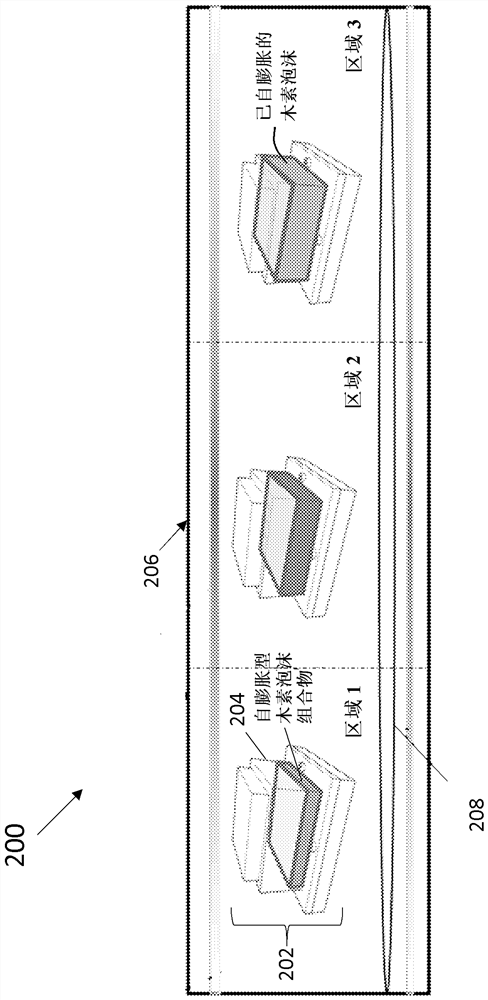Self-expanding lignofoam compositions and lignofoams made therefrom
A self-expanding, composite technology applied in the field of lignin foam
- Summary
- Abstract
- Description
- Claims
- Application Information
AI Technical Summary
Problems solved by technology
Method used
Image
Examples
Embodiment 1
[0033] In this example, 240 grams of kraft lignin (raw lignin) and 60 grams of poly(ethylene) powder were placed in a blender and mixed very well for 30 minutes. Then transfer the composition to figure 2 The molding chamber of the molding system. Experiments were performed as follows. The composition is cold pressed at a pressure between 0 (no pressure) and 10 MPa. The (pressed) composition is transferred in the forming chamber to the heating chamber and a metal plate is placed on the pressed composition, the metal plate exerting a pressure of 10-10,000 Pa. The heating chamber is then heated to a temperature of 200-260° C. at a rate of 5-20° C. / minute and held for 30-60 minutes. Next, the molding chamber is cooled to room temperature. These experiments produced open-celled, self-expanding lignin foams, which were subsequently removed from the mould. Results from a representative sample of lignin foam that had self-expanded are shown in Table 1 below.
Embodiment 2
[0035] In this example, 270 grams of kraft lignin (raw lignin) and 30 grams of polypropylene were placed in a mixer and mixed very thoroughly for 30 minutes. Then transfer the composition to figure 2 The molding chamber of the molding system. Experiments were performed as follows. The composition is cold pressed at a pressure between 0 (no pressure) and 10 MPa. The (pressed) composition is transferred in the forming chamber to the heating chamber and a metal plate is placed on the pressed composition, the metal plate exerting a pressure of 10-10,000 Pa. The heating chamber is then heated to a temperature of 220-260° C. at a rate of 5-20° C. / minute and held for 30-60 minutes. Next, the molding chamber is cooled to room temperature. These experiments produced open-celled, self-expanding lignin foams, which were subsequently removed from the mould. Results from a representative sample of lignin foam that had self-expanded are shown in Table 1 below.
Embodiment 3
[0037] In this example, 250 grams of kraft lignin (raw lignin) and 50 grams of poly(methyl methacrylate) were placed in a mixer and mixed very thoroughly for 30 minutes. Then transfer the composition to figure 2 The molding chamber of the molding system. Experiments were performed as follows. The composition is cold pressed at a pressure between 0 (no pressure) and 10 MPa. The (pressed) composition is transferred in the forming chamber to the heating chamber and a metal plate is placed on the pressed composition, the metal plate exerting a pressure of 10-10,000 Pa. The heating chamber is then heated to a temperature of 200-250° C. at a rate of 5-20° C. / minute and held for 30-60 minutes. Next, the molding chamber is cooled to room temperature. These experiments produced open-celled, self-expanding lignin foams, which were subsequently removed from the mould. Results from a representative sample of lignin foam that had self-expanded are shown in Table 1 below.
PUM
 Login to View More
Login to View More Abstract
Description
Claims
Application Information
 Login to View More
Login to View More - R&D
- Intellectual Property
- Life Sciences
- Materials
- Tech Scout
- Unparalleled Data Quality
- Higher Quality Content
- 60% Fewer Hallucinations
Browse by: Latest US Patents, China's latest patents, Technical Efficacy Thesaurus, Application Domain, Technology Topic, Popular Technical Reports.
© 2025 PatSnap. All rights reserved.Legal|Privacy policy|Modern Slavery Act Transparency Statement|Sitemap|About US| Contact US: help@patsnap.com



